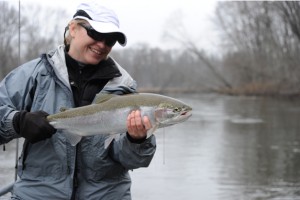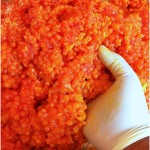Captain Ben Wolfe from Sport Fish Michigan provides tips for creating salmon egg spawn bags for steelhead fishing.
Tag Archives: eggs
Steelhead Fishing on a Rare Day Off
A couple of days ago, I had a rare opportunity when one of our Wolfe Outfitters trips was cancelled at the last minute, and I had a free day. My Wolfe Outfitters guide, Matt, and I went fishing. We took Janice with us – the Recreation Manager at Crystal Mountain Resort, and the woman with whom I worked to create Wolfe Outfitters’ partnership with Crystal Mountain Resort.
A slight warming trend made for a nice day out on the water. Add in that we didn’t get to the ramp until after 10am, and we were relaxed and ready to go! Why not be more informal and relaxed when it comes to fun fishing? Janice even made our lunches the previous evening to be heated on Matt’s on-board grill.
November steelhead tend to relate to a few different patterns. Cured salmon eggs tied in spawn sacks and round-bodied crank baits dominate for gear anglers. Fly anglers have options such as beads, nymphs and streamers. Depending on water temperatures, the king salmon that run the rivers have likely ended their spawn, and the steelhead that gorge on the eggs in the river now have to find another food source to sustain them throughout the remainder of fall and winter.
The single egg pattern holds up well throughout winter, but it isn’t as effective as other techniques, as the salmon eggs are no longer prevalent in the river. However, spawn sacks offer tempting scent and life-like softness that even picky steelhead oftentimes just cannot pass up.
During the mid-fall period when the salmon have finished spawning, and the steelhead are still active with warmer water temperatures, throwing round-bodied crank baits can be an absolute blast. Similar to throwing longer bodied crank baits for king salmon, the technique is the same. Casts are made downstream, close to the bank and to cover (holding water). A medium retrieve, allowing the deep diving baits to work their magic as they are pulled through seams and creases induce violent strikes that anglers thoroughly enjoy. Medium weight rods are used to cushion these aggressive takes, yet have enough backbone to turn large steelhead away from logjams and snarly cover. For big steelhead on the Big Manistee River, I use 20 pound braided line, and either 14-pound fluorocarbon leaders or 12 pound, if the conditions are really clear and the flow is low. Fluorocarbon has the same refractive index as water, and is nearly invisible to fish. Steelhead often strike out of a feeding response, and looking as natural as possible is a huge advantage for my guide customers and me.
I’m glad that we were able to get out, even if it was for only 3 hours of fishing. We had a number of bites, and were able to land some beautiful Manistee River steelhead. And cooperatively mild weather made it all that much sweeter! It was nice to fish with good people, and experience the fun of fishing for oneself for a few hours. Does casting crank baits using spinning gear or casting flies for steelhead sound like fun? I can guarantee you that it is. And with one of the world’s premier steelhead fisheries at our doorstep, Wolfe Outfitters is ready to get you out on the water for your own adventure. Happily, I just had mine!
Curing Salmon Eggs
Part of being a prepared guide, fishing with customers for salmon and steelhead, is having the right equipment and bait. My favorite trips when fishing with my Manistee River Salmon Guide Service, are the ones where I have a strong crank bait bite where we can cast deep diving crank baits like the Storm Thunderstick Jr. for truly ferocious strikes.
Salmon in the rivers don’t really feed on the forage that they fed on when they were in the lakes and oceans. It has been scientifically proven that some salmon will eat 10-12 eggs a day to try to maintain body weight, and fat conditioning while fighting the current. 10-12 salmon eggs a day is like me eating 10-12 kernels of popcorn. Then again, I’m not fighting current, trying to spawn.
What salmon do, however, is become terrifically territorial, and a slowly moving crank bait invading their space is met with a killing instinct that we as anglers absolutely cannot get enough of. They don’t nibble, they don’t half-heartedly bump; they simply try to kill. Talk about a fun bite! Bent hooks; shaking knees; stuttered speech; 4-letter words and big smiles are all indicative proof of a salmon trying to kill a crankbait that was cast by one of my customers. It’s truly unbelievable. People can’t believe the power and the sudden ferocity of these strikes. Oh, and it’s purely addictive.
Despite the addictive nature of getting bites casting crank baits, one other thing that I use as a guide are the use of cured salmon eggs. Depending on how many eggs need to be cured, I may spend 2-4hours daily curing eggs for the week’s trips. This is a messy and lengthy process by which I carefully bleed out the egg skeins, trying to drain as much blood as possible. Cures are able to handle the curing of the eggs, but not the blood, which will taint the final product. Properly cured eggs, that are free of blood are absolutely essential to getting the number of bites that customers rely on me for. Although it takes a lot of time after guide trips, being able to put my customers on additional fish that bite these cured eggs is priceless. Whether it’s fishing big chunks in skein form, or tied into small spawn sacks with only a few eggs in them, it’s all part of being the best guide that I can be. We as guides always have to be able to say to a customer after the end of a guide trip that we tried and did everything that we could to maximize our bites and opportunities.
Curing 10 pounds of salmon eggs. This started with perfectly bled out females, egg skeins that were carefully cut out of the hens, then the skeins were bled out and drained, and butterflied all prior to adding the secret curing ingredients.
Edgar’s Obsessed
Cats are cats, and I happen to have 2 of them.







